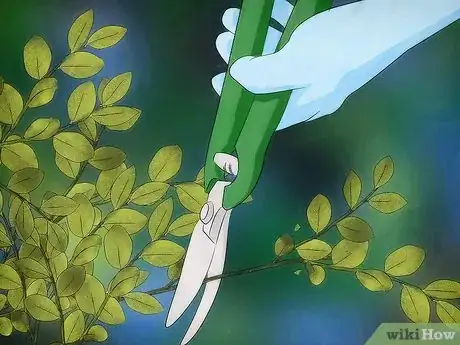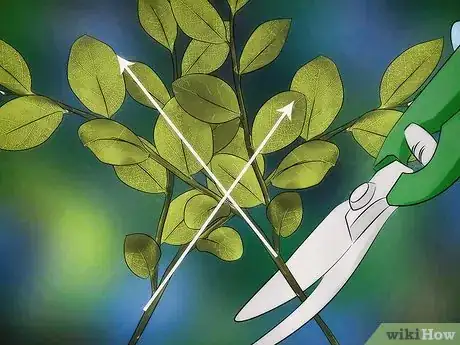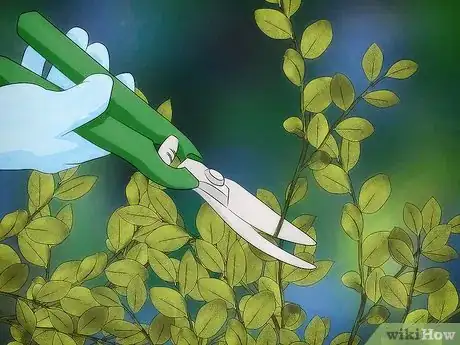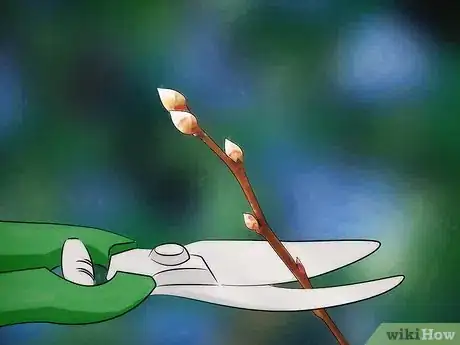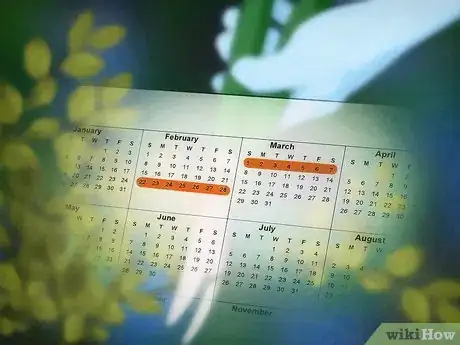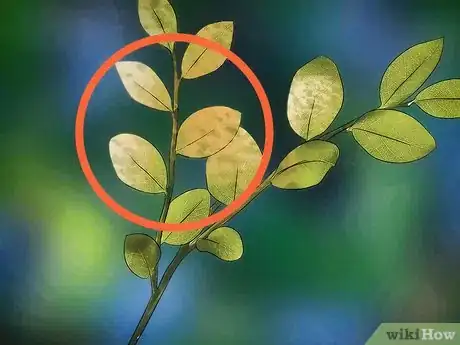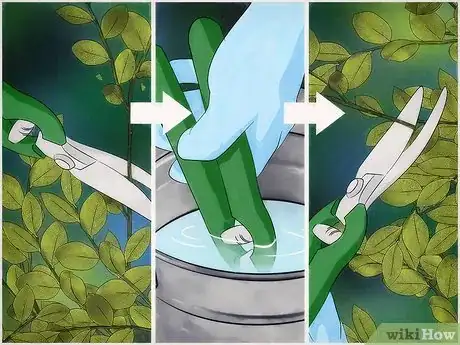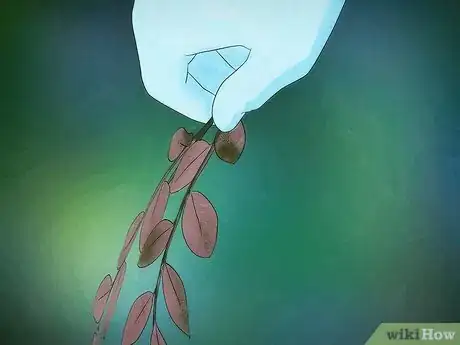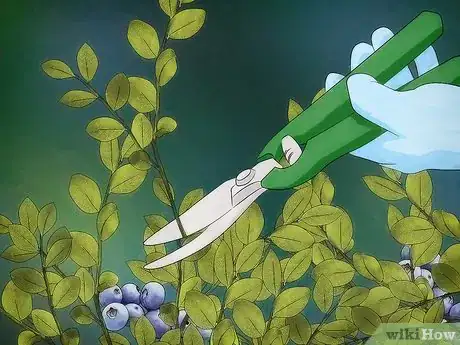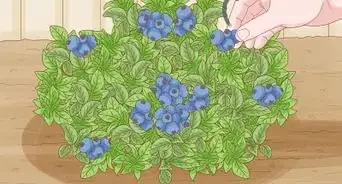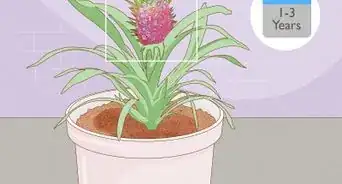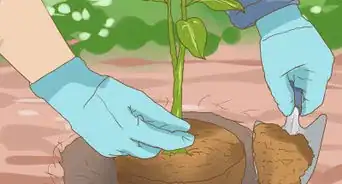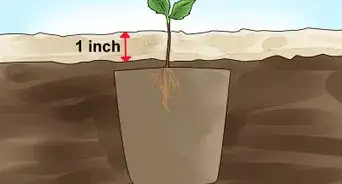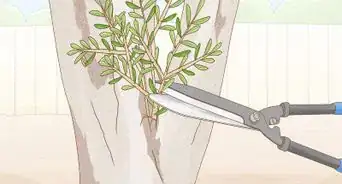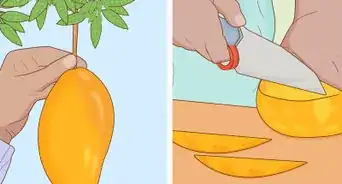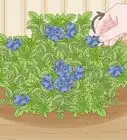This article was co-authored by Andrew Carberry, MPH. Andrew Carberry is a Food Systems Expert and the Senior Program Associate at the Wallace Centere at Winrock International in Little Rock, Arkansas. He has worked in food systems since 2008 and has experience working on farm-to-school projects, food safety programs, and working with local and state coalitions in Arkansas. He is a graduate of the College of William and Mary and holds a Masters degree in public health and nutrition from the University of Tennessee.
wikiHow marks an article as reader-approved once it receives enough positive feedback. In this case, 95% of readers who voted found the article helpful, earning it our reader-approved status.
This article has been viewed 158,458 times.
Regular pruning of blueberry bushes is important to keep them from becoming overgrown and unproductive. Training young blueberry bushes by pruning them regularly during the first two years promotes proper structure of the plant, which in turn supports maximum production of fruit. By recognizing mature canes and cutting properly, you'll train blueberry bushes to create productive plants.
Steps
Knowing the Basics of Blueberry Growth and Pruning Young Bushes
-
1Know where blueberry bushes produce fruit. Blueberries grow on the side-shoots, off of the main branches of the bushes.[1]
- Blueberries only grow on branches that are at least one year old. Branches over four years may have a smaller crop. You must prune the bushes so that they provide enough new growth for blueberry production next year.[2]
-
2Understand the importance of pruning. If blueberry bushes are not pruned back every year, they can overproduce in one year. That can lead to the bushes only producing fruit every other year.[3]
- You also prune to keep the bush under control, as you don't want it to be too tall. If it's too tall, it will be difficult to harvest the blueberries.[4] Additionally, you need to thin out the middle so that it can get proper airflow, discouraging disease.[5]
- Pruning also opens up the middle to sunlight, providing nutrients and ripening the fruit.[6]
Advertisement -
3Train young blueberry bushes. For the first two years of life, you must train your blueberry bushes so that they grow properly.
- Remove crossed branches. In the first two years, you need to cut any branches that cross each other. By doing so, you're allow the bush to focus its resources on canes growing straight up, which will be stronger and help you create a better-shaped bush. It will also keep the fruit off the ground.[7]
- Focus on creating the right shape of bush. In the second year, cut away any branches that didn't grow much in the last season. Leave the ones that have grown taller, though you may prune them back some in the next step.[8]
-
4Cut the longest stems to encourage growth in the second year. Following the first season, you can cut the longest canes back to 2/3rds of their length if the bush didn't grow much in the first year. This pruning will help it branch out.[9]
-
5Cut away fruit buds. Any time you see a fat fruit bud in the first 2 years, as opposed to the flat buds of the leaves, you need to remove the bud. Cut away any of these buds you see with sharp shears. The bush needs to focus on growing, not producing fruit.[10]
- Sometimes flowers might grow from fruit buds that you missed previously. Cut these away as well if you find them.
Pruning an Older Blueberry Bush
-
1Know when to prune. Prune over the winter. You can prune as early as November or as late as March. However, the best time to prune is late February to the beginning of March.[11]
- This time of year is best because you can see which new buds will produce fruit (fat buds) and which ones will produce leaves (flat buds).[12]
-
2Use a pair of sharp shears, loppers, a pair of gloves, and disinfectant in a bucket.[13] When cutting, always use a pair of sharp shears. Dull shears can cause you to use too much pressure, which can lead to injury. It will also make cutting more difficult and may damage your plant. Wear the gloves while pruning to protect your hands.[14]
-
3Begin with diseased branches. Cut any canes that have diseases on them first. Look for shriveled branches or discolored branches.
-
4Dip the shears in disinfectant. Between bushes, dip the shears into the disinfectant to stop the spread of disease. Shake off the disinfectant before moving on to the next bush.[15]
- You can also use a rag or towel that has been soaked in rubbing alcohol. Wipe down the shears to disinfect them.
-
5Prune out damaged canes. Cut any branches that look damaged due to weather or other circumstances. Damaged branches will lose leaves, look shriveled, or be broken due to wind.
-
6Cut out soft lower twig growth or any growth that looks spindly. That is, cut out growth that doesn't look strong.[16] Look for growth near the bottom that started late in the previous season, as it will not have had enough time to develop fully.[17]
- Remove this late growth near the bottom of the plant, preserving resources for the top of the plant.[18] These twigs are the ones that didn't grow enough in the last season, so they are too small to produce any fruit this year.[19]
- Additionally, cut out any lower branch that will produce fruit that touches the ground. Fruit should not touch the ground while growing. These will branches that go out at an angle rather than straight up or branches that are bending towards the ground.[20]
-
7Cut off upper twig growth. If a cane did not produce fruit this year, cut back the extra growth from last year.[21] You can recognize the twiggy growth because it will have an abundance of smaller twigs, more than other branches. Also, the wood that produces this type of growth will not be as shiny as newer wood growth.[22]
- When cutting, take it back to a place where the branch looks stronger, one that is growing upwards rather than sideways.[23] Make the cut right above an outward facing bud, or do it on the next branch.
-
8Cut back older canes, including ones that haven't produced in several years.[24] Remove older canes at ground level, especially if your bush is growing too tall. Bushes are too tall if you can't reach up to harvest easily. You should leave at least seven canes, however. [25]
- Prune the canes back to where a new shoot is taking off from the cane.[26]
- You should not have any canes that are older than six years old.
-
9Limit mature cane removal. Only remove 2 or 3 mature canes per year to help sustain growth. Because canes stop producing as many blueberries after four years, start with the oldest canes. Mature canes are at least two years old.
Community Q&A
-
QuestionCan I prune in July?
 Community AnswerFruit is borne on one-year wood. Pruning in summer and fall, before buds are visible to the eye, sacrifices next year's fruit. Late pruning also stimulates new growth that leaves bushes vulnerable to winter cold damage. With dormant pruning, canes are seen clearly and large flower buds stand out on one-year wood.
Community AnswerFruit is borne on one-year wood. Pruning in summer and fall, before buds are visible to the eye, sacrifices next year's fruit. Late pruning also stimulates new growth that leaves bushes vulnerable to winter cold damage. With dormant pruning, canes are seen clearly and large flower buds stand out on one-year wood. -
QuestionCan I trim back several feet of new growth safely?
 DonaganTop AnswererYes, assuming it's a healthy bush. Just keep it well watered, and it should be fine.
DonaganTop AnswererYes, assuming it's a healthy bush. Just keep it well watered, and it should be fine. -
QuestionWhen should I prune blueberries?
 Community AnswerThe best time is the late fall normally around the first frost. You can also prune in the spring before the leafs come on. If you prune in the summer the growth and berry amount will be a lot less.
Community AnswerThe best time is the late fall normally around the first frost. You can also prune in the spring before the leafs come on. If you prune in the summer the growth and berry amount will be a lot less.
References
- ↑ http://www.growveg.com/growblogpost.aspx?id=227
- ↑ http://www.growveg.com/growblogpost.aspx?id=227
- ↑ http://www.growveg.com/growblogpost.aspx?id=227
- ↑ https://www.clemson.edu/extension/hgic/plants/vegetables/small_fruits/hgic1401.html
- ↑ http://www.growveg.com/growblogpost.aspx?id=227
- ↑ http://www.growveg.com/growblogpost.aspx?id=227
- ↑ https://www.rhs.org.uk/advice/profile?pid=85
- ↑ https://media.oregonstate.edu/media/t/0_05v1qew6
- ↑ http://www.growveg.com/growblogpost.aspx?id=227
- ↑ http://www.growveg.com/growblogpost.aspx?id=227
- ↑ https://www.rhs.org.uk/advice/profile?pid=85
- ↑ https://www.rhs.org.uk/advice/profile?pid=85
- ↑ https://media.oregonstate.edu/media/t/0_05v1qew6
- ↑ https://media.oregonstate.edu/media/t/0_05v1qew6
- ↑ https://media.oregonstate.edu/media/t/0_05v1qew6
- ↑ https://www.clemson.edu/extension/hgic/plants/vegetables/small_fruits/hgic1401.html
- ↑ http://extension.oregonstate.edu/gardening/prune-blueberries-yearly-more-fruit
- ↑ http://www.nbh.psla.umd.edu/guides/appendix3.html
- ↑ https://media.oregonstate.edu/media/t/0_05v1qew6
- ↑ https://media.oregonstate.edu/media/t/0_05v1qew6
- ↑ https://www.rhs.org.uk/advice/profile?pid=85
- ↑ https://media.oregonstate.edu/media/t/0_05v1qew6
- ↑ https://www.rhs.org.uk/advice/profile?pid=85
- ↑ http://extension.oregonstate.edu/gardening/prune-blueberries-yearly-more-fruit
- ↑ https://www.clemson.edu/extension/hgic/plants/vegetables/small_fruits/hgic1401.html
- ↑ https://www.rhs.org.uk/advice/profile?pid=85
- ↑ http://extension.oregonstate.edu/gardening/prune-blueberries-yearly-more-fruit
About This Article
To prune a young blueberry bush, remove crossed branches to allow the canes to grow straight up. This will produce stronger canes and keep fruit off the ground. Also during the first 2 years, cut away any buds, as the bush needs to focus on growing, not producing. Then, in the second year, cut away branches that didn’t grow much in the last season and cut the longest canes back to two-thirds of their length to help the bush branch out. For older bushes, prune over the winter by removing diseased branches, spindly twigs, and damaged canes. To learn more from our Food Systems Expert co-author, like what time of the growing season is best to prune your blueberry bushes, keep reading!

